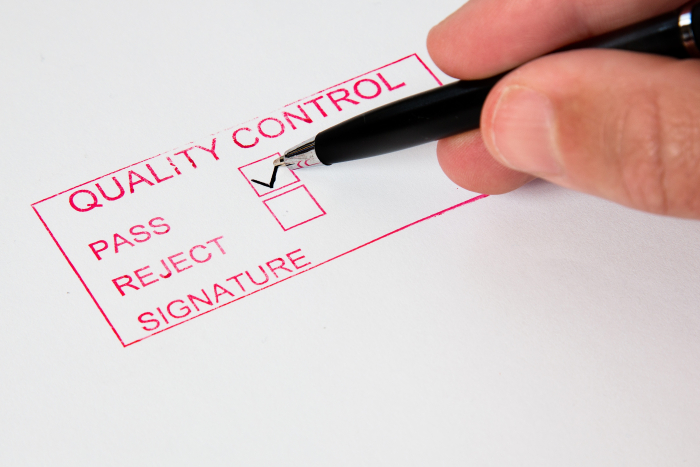
 Data Structure
Data Structure Networking
Networking RDBMS
RDBMS Operating System
Operating System Java
Java MS Excel
MS Excel iOS
iOS HTML
HTML CSS
CSS Android
Android Python
Python C Programming
C Programming C++
C++ C#
C# MongoDB
MongoDB MySQL
MySQL Javascript
Javascript PHP
PHP
- Selected Reading
- UPSC IAS Exams Notes
- Developer's Best Practices
- Questions and Answers
- Effective Resume Writing
- HR Interview Questions
- Computer Glossary
- Who is Who
Quality Control: Definition, Benefits, and Techniques
There is no single meaning of the word. Regardless of the subjective understanding of "benefit," performance measurement is the act of testing and measuring items to guarantee they satisfy a standard. A company can use this procedure to analyze, sustain, and enhance efficiency.
Evaluation is often performed at each stage of a production or commercial operation. Workers typically start evaluating using data taken from the workstation, items, and ingredients. Monitoring at numerous stages can assist in determining the root cause of a quality issue and the taken to mitigate steps to minimize the damage again.
Performance testing processes that may be utilized in non-manufacturing organizations include operations assessments, polls, statistics, investigations, and internal audits. Any approach or method may be used by a corporation to verify that the end merchandise is healthy, ensuring compliance, and satisfying client expectations.

Quality Control Roles
In addressing the question, "What would be performance measurement?" it is vital to recognize that it encompasses a wide range of tasks and functions. Furthermore, it is not to be mistaken for product testing. QA examines the techniques was using to avoid faults, and QA focuses on the testing and explores the relation utilized in assessing customer satisfaction.
To complete reality operations and execute assessments, QA employs specialized data sources. A product testing specialist is responsible for verifying these measures to a guideline recommended by the maintenance departments, corporate policy, and industry or covered entities. Build quality will provide recommendations according to the information gathered
The whole path also shows how product testing and quality inspection differ. To keep goods will become faulty, product testing examines the entire picture. Performance measurement, by contrast, hand, evaluates whether or not the piece is flawed. Both positions fall so under the wide category of quality control.
Techniques
Inspection
Inspection is part of a quality management approach responsible for ensuring that goods function according to the requirements specified for them. It entails regular monitoring and measurement beforehand, though, and shortly after the manufacturing process. Verification is ongoing due to the myriad factors that feed into fabrication.
Since a tester was never under pressure to dismiss the performance of someone with whom he has strong emotional ties, unified evaluation assures unbiased oversight.
It is simple to keep track of objects that are accepted or denied with the centralized examination.
SQC
SQC is a simple statistical tool for measuring the amount to which items are satisfied while requiring inspecting individual pieces made and identifying the degree to which the variances that occur surpass typical estimates. It allows us to want to test a new item.
Assessment results in output authorization, whereas SQC allows administrators to take measures to ensure that goods perform. As such assessment helps one "toward being wiser since the incident" but SQC permits one "to grow better prior to the date occurrence.
Acceptance Sampling
Acceptance sampling is performed on article items to verify performance characteristics established by the organization, which include both qualities and uncertainties. If indeed the material can not satisfy the specified quality criteria, the lot is refused, and such investigation is performed to discover the origin and correct the problems. Observation is used to do approval testing, which requires actual validation of color, height, geometry, and so forth.
The primary goals of the assessment are as follows ?
Hazard detection and prevention in goods and processes.
Identifying defective components or products and preventing their continued usage or use.
To bring the invention fault to the attention of the competent bodies for essential and remedial measures.
Taguchi
Again a quality control strategy that stresses the functions of research activities, industrial design, and business development in lowering the frequency of faults and errors in goods is the Taguchi Process. In quality checks, the Taguchi Method prioritizes planning above the factory, attempting to minimize deviations in output when any arise.
Benefits
The most significant benefit of implementing checking is that it promotes and fosters aesthetic value among laborers, which became extremely beneficial in obtaining the target reliability in production.
Clients profit substantially from safety testing since they receive higher-quality items. It brings them pleasure.
Production expenses are significantly decreased by conducting efficient monitoring and supervision of industrial tasks and procedures. Continuous improvement also prevents the manufacturing of substandard items and waste, lowering expenditures significantly.
The durability method guarantees that financial facilities are used to their full potential, reducing sources of waste of all kinds.
Performance measurement results in testing efficiencies and significantly lowers inspection costs.
Reliability increases the concern's trust in the thoughts of individuals by providing higher-quality things and meeting the requirements of customers. A well-known company may readily acquire money from investors.
An efficient assurance system is extremely beneficial in raising job satisfaction, as they believe they are helping the company produce proportionally higher affordable products.
Companies must discover innovative methods to differentiate themselves by delivering greater responsiveness than potential counterparts. The business rivalry has expanded as activities and items are provided via a variety of outlets. Companies have created technically adequate items that demand a couple of days later support to compete in the phone market.
In the retail sector, automation is used to boost customer efficiency. Manufacturers may promote their productivity by offering more comfort. For instance, devices, booking computers, security code payout equipment, and so on. These gadgets enhance the effectiveness of exactness.
Career
Perhaps there are variances in the path to a job in inspection depending on the sector. Yet, you will often require numerous years of expertise in your field. After satisfying training and work experience criteria, you may be recruited as a quality assurance or assurance partner.
After learning on the job as a qualified expert or companion, you may advance to the post of assistant specialized and start supervising organizations of product testing experts.
You may be expected to attend mentoring classes offered by your business or to get qualifications including Six Sigma. A specialist credential, such as Accredited Operator, may also be required.
Quality Control assists firms in reducing costs and creating the production. Specialist follows a strong methodology to guarantee that the appropriate quality standard is attained. Through this, we can specialize in helping customers in the training and publications sectors due to our substantial relevant data in these areas

